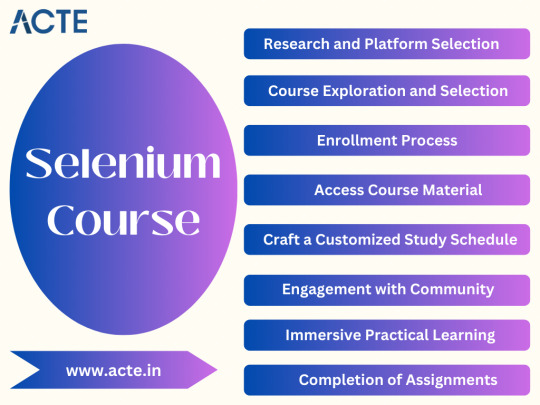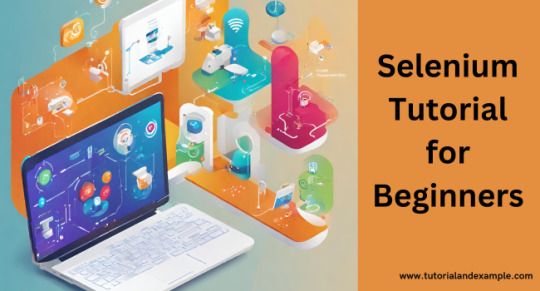#Selenium Tutorials
Explore tagged Tumblr posts
Text

Selenium Tutorial
Learn how to automate web applications with this easy-to-follow Selenium Tutorial. Perfect for beginners and testers, it covers everything from setup to advanced testing techniques using Selenium WebDriver. Start testing smarter today!
For more info visit here: https://www.tpointtech.com/selenium-tutorial
0 notes
Text
Selenium with Python Tutorial: A Beginner-Friendly Guide

If you’re new to web automation or testing, then this Selenium with Python Tutorial is the perfect place to start. Selenium is a powerful tool used to automate web browsers. When combined with Python, it becomes even more flexible and easy to use.
Python is known for its simple syntax and readability. That’s why many testers and developers prefer using it with Selenium. With just a few lines of code, you can automate tasks like clicking buttons, filling out forms, and navigating web pages.
This Selenium with Python Tutorial is designed to help you understand the basics without feeling overwhelmed. First, you'll learn how to install the necessary tools, like Python and the Selenium library. Next, you’ll explore how to open a browser, visit websites, and interact with different elements on the page.
You’ll also discover how Selenium is useful for testing web applications. It can help find bugs early by simulating user actions and checking if everything works correctly. Whether you're a student, tester, or developer, learning Selenium with Python can save you time and make your work more efficient.
The best part is that you don’t need to be a programming expert to get started. With a little practice and patience, anyone can learn web automation.
To dive deeper into this topic, check out a detailed tutorial at: Selenium with Python Tutorial
0 notes
Text
AI Automated Testing Course with Venkatesh (Rahul Shetty) Join our AI Automated Testing Course with Venkatesh (Rahul Shetty) and learn how to test software using smart AI tools. This easy-to-follow course helps you save time, find bugs faster, and grow your skills for future tech jobs. To know more about us visit https://rahulshettyacademy.com/
#ai generator tester#ai software testing#ai automated testing#ai in testing software#playwright automation javascript#playwright javascript tutorial#playwright python tutorial#scrapy playwright tutorial#api testing using postman#online postman api testing#postman automation api testing#postman automated testing#postman performance testing#postman tutorial for api testing#free api for postman testing#api testing postman tutorial#postman tutorial for beginners#postman api performance testing#automate api testing in postman#java automation testing#automation testing selenium with java#automation testing java selenium#java selenium automation testing#python selenium automation#selenium with python automation testing#selenium testing with python#automation with selenium python#selenium automation with python#python and selenium tutorial#cypress automation training
0 notes
Text
Getting Started with Selenium: The Ultimate Beginner’s Guide to Automation Testing

If you're new to web automation, Selenium is an excellent tool to start with. This beginner-friendly guide will help you understand the basics of Selenium and how it can simplify web testing.
What is Selenium?
Selenium is a powerful open-source tool used to automate web browsers. It supports multiple programming languages, including Java, Python, and C#, making it versatile for developers and testers. Selenium allows you to perform repetitive tasks on websites, such as filling out forms, clicking buttons, and navigating pages, all without manual intervention.
Why Use Selenium?
Manual web testing can be time-consuming and prone to errors. Selenium helps by automating these tasks, ensuring faster and more accurate results. It supports multiple browsers, like Chrome, Firefox, and Safari, and can run on various operating systems, including Windows, Mac, and Linux.
How to Start with Selenium?
To begin, you'll need to install Selenium WebDriver and set up your environment. While no coding is included here, understanding basic concepts like browsers, elements, and testing scenarios is essential. Selenium works by interacting with web elements like text boxes, buttons, and links, mimicking user actions to verify functionality.
Benefits of Learning Selenium
Saves time with automated testing.
Improves accuracy by reducing manual errors.
Enhances your career in software testing and development.
Ready to dive deeper into Selenium? Visit Selenium Tutorial for detailed step-by-step guidance and examples.
0 notes
Video
youtube
Mastering Python Automation: Step-by-Step PyCharm Installation
#youtube#🚀 Exciting News! 🚀 We've started a Python Selenium tutorial on YouTube! 📺 If you're interested in learning for free simply click on the s
1 note
·
View note
Text
Streamlining MySQL Deployment Across Multiple Infrastructures with Selenium WebDriver
In today's fast-paced digital landscape, businesses often find themselves managing complex IT infrastructures spread across various environments. Deploying and managing databases, such as MySQL, across these diverse infrastructures can be a daunting task, requiring meticulous coordination and careful execution. However, with the right tools and strategies in place, this process can be streamlined and simplified.
Enter Selenium WebDriver – a powerful automation tool primarily used for testing web applications but with capabilities that extend far beyond. Leveraging Selenium WebDriver, businesses can automate various aspects of their infrastructure management, including the deployment and configuration of MySQL databases across multiple environments.
Understanding Selenium WebDriver Selenium WebDriver is an open-source automation framework that allows users to automate interactions with web browsers. It provides a range of programming interfaces in languages such as Java, Python, and C#, making it accessible to developers and system administrators alike.
One of the key features of Selenium WebDriver is its ability to interact with web elements on a page, simulating user actions such as clicking buttons, filling out forms, and navigating through web pages. This functionality can be harnessed to automate repetitive tasks involved in deploying and configuring MySQL databases across different infrastructures.
Automating MySQL Deployment Deploying MySQL across multiple infrastructures traditionally involves manual intervention at various stages of the process, from provisioning servers to configuring database settings. This manual approach not only consumes valuable time and resources but also increases the risk of human error.
By leveraging Selenium WebDriver, businesses can automate many of these tasks, significantly reducing the time and effort required for deployment.
learn Selenium from industry experts
Here's how:
Infrastructure Provisioning: Selenium WebDriver can be used to automate the provisioning of servers across different environments, whether it's on-premises, in the cloud, or in a hybrid setup. By interfacing with infrastructure management tools or cloud service providers' APIs, Selenium can spin up virtual machines or containers as needed.
MySQL Installation and Configuration: Once the servers are provisioned, Selenium WebDriver can automate the installation and configuration of MySQL on each instance. It can simulate user interactions with the command-line interface or web-based installation wizards to ensure consistent configuration across all environments.
Database Initialization: After MySQL is installed, Selenium WebDriver can automate the process of initializing the database, creating schemas, tables, and user accounts as required. It can execute SQL scripts or interact with MySQL's administrative interfaces to perform these tasks efficiently.
Integration Testing: Selenium WebDriver can also be used to automate integration tests on the deployed MySQL instances to ensure they are functioning correctly. It can simulate database queries and transactions, verifying that the databases are responsive and performing as expected.
Benefits of Automation
Automating MySQL deployment across multiple infrastructures with Selenium WebDriver offers several benefits:
**Consistency: **Automation ensures that MySQL databases are deployed and configured consistently across all environments, reducing the risk of configuration drift and compatibility issues.
**Efficiency: **By automating repetitive tasks, businesses can deploy MySQL databases faster and with fewer errors, freeing up resources to focus on more strategic initiatives.
Scalability: Automation enables businesses to scale their infrastructure more efficiently, allowing them to deploy MySQL databases across new environments or expand existing ones with minimal manual intervention.
Reliability: Automated deployments are less prone to human error, resulting in more reliable and resilient MySQL infrastructures.
Conclusion
Deploying MySQL across multiple infrastructures can be a complex and time-consuming process, but with Selenium WebDriver, businesses can automate many of the tasks involved, streamlining the deployment process and ensuring consistency and reliability across all environments. By harnessing the power of automation, organizations can deploy MySQL databases faster, more efficiently, and with greater confidence, empowering them to focus on innovation and growth.
0 notes
Text
Mastering Advanced Python Interview Questions for Automation Testing

Mastering Advanced Python Interview Questions for Automation Testing
Introduction
Are you ready to take your software testing skills to the next level and ace your automation testing interviews? In this comprehensive guide, we'll delve into advanced Python interview questions tailored for automation testing roles. Whether you're aiming for a junior or senior position, these questions will help you showcase your expertise and land your dream job.
Table of Contents
Sr#
Headings
1
Introduction
2
Python and Selenium WebDriver Overview
3
Advanced Python Concepts
4
Python Decorators and Generators
5
Exception Handling in Python
6
Python Multithreading and Multiprocessing
7
Python Best Practices for Automation Testing
8
Python Libraries for Automation Testing
9
Advanced Python Functions
10
Conclusion
11
Frequently Asked Questions (FAQs)
Python and Selenium WebDriver Overview
Python's versatility and readability make it a popular choice for automation testing, especially when combined with Selenium WebDriver. Selenium WebDriver is a powerful tool for automating web applications, and Python's integration with Selenium makes it a go-to language for automation testers.
Advanced Python Concepts
To excel in Automation with Python , you need a deep understanding of advanced Python concepts. From decorators and generators to multithreading and multiprocessing, these concepts play a crucial role in writing efficient and maintainable automation test scripts.
Python Decorators and Generators
Decorators and generators are advanced Python features that can significantly enhance your selenium with python scripts. Decorators allow you to modify or extend the behavior of functions, while generators enable you to create iterators efficiently.
Exception Handling in Python
Exception handling is crucial in automation testing to ensure that your scripts can gracefully handle errors and unexpected situations. python selenium tutorial provides robust support for exception handling through try-except blocks, allowing you to write more robust and reliable test scripts.
Python Multithreading and Multiprocessing
Multithreading and multiprocessing are essential concepts for improving the performance of your automation testing scripts. python automation testing provides built-in libraries such as threading and multiprocessing to support these concurrency models.
Python Best Practices for Automation Testing
Following best practices is key to writing maintainable and efficient automation testing scripts. From using descriptive names for functions and variables to organizing your code into modules, these practices will help you write better automation tests.
Python Libraries for Automation Testing
python for automation testing offers a plethora of libraries and frameworks that can streamline your automation testing efforts. From unit testing frameworks like pytest to web scraping libraries like BeautifulSoup, these libraries can significantly enhance your automation testing workflow.
Advanced Python Functions
Understanding advanced Python function concepts such as lambda functions, map, filter, and reduce can make your automation testing scripts more concise and readable. These concepts allow you to write more expressive code and handle complex data transformations effectively.
Conclusion
Mastering advanced Automation Testing with Python interview questions is essential for excelling in automation testing roles. By familiarizing yourself with these concepts and practicing with real-world scenarios, you can demonstrate your expertise and stand out in your automation testing interviews.
Frequently Asked Questions (FAQs)
What are the key differences between Python 2 and Python 3?
Python 3 introduced several syntax changes and improvements over Python 2, including better Unicode support, syntax enhancements, and improved security features.
How can I improve the performance of my Python automation testing scripts?
To improve performance, consider using multithreading or multiprocessing to parallelize your tasks. Additionally, optimizing your code and using efficient data structures can also help improve performance.
What are some common pitfalls to avoid in Python automation testing?
Some common pitfalls include using hard-coded values instead of variables, neglecting error handling, and not considering edge cases in your test scripts.
How can I handle dynamic elements in Selenium WebDriver using Python?
You can handle dynamic elements in selenium webdriver python using techniques such as waiting for the element to be present, using explicit waits, or using dynamic locators to locate the element.
What are some best practices for organizing Python automation testing scripts?
Some best practices include organizing your code into modules and packages, using descriptive names for functions and variables, and writing clear and concise documentation for your scripts.
By mastering these advanced Python interview questions, you'll be well-equipped to tackle any automation testing interview with confidence. Start practicing these concepts today and take your automation testing skills to new heights!
#selenium webdriver#Automation with Python#python selenium tutorial#python automation testing#python for automation testing#Automation Testing with Python#selenium webdriver python
0 notes
Text
#Selenium#selenium certification#selenium certification course online#Selenium Online#selenium online training#selenium online training courses#selenium tutorial#Selenium Training Courses#tutorial academy
0 notes
Text

[AC23 - DAY 5] SELENIUM SET - GAME EDITION
New meshes
HQ/BG compatible
All LODs
Custom thumbnails
Disallowed for random
DOWNLOAD:
PATREON [PUBLIC RELEASE: DEC 30]
FULL GAME EDITION COLLECTION
------------------------------------------------------------------------------
[AC23 - DAY 5] SELENIUM SET - BLENDER EDITION [SHOWN ON COVER]
New meshes
HQ textures [4096x2048]
4 diffuse textures for each model + normal maps
Material Nodes for customization
Tutorials included
DOWNLOAD:
PATREON
FULL BLENDER EDITION COLLECTION
-------------------------------------------------------------
WHAT IS BLENDER EDITION?
Blender Edition is a special edition that has more texture space (usually 2048x2048) and can be used only in Blender due to different UV Mapping. This edition allows you to create renders with more quality and flexibility than models exported from the game itself.
Archive with this edition contains .blend file, diffuse textures, normal maps and tutorials on how to use it.
IMPORTANT NOTE:
Blender Editions will be available to Platinum and Diamond members only. Early Access doesn't apply to Blender Edition since this edition weren't made for the game and is basically a separate 3D model.
#sims 4 cc#sims 4#sims 4 custom content#sims 4 accessories#sims 4 jewelry#sims 4 earrings#sims 4 necklace#sims 4 choker
85 notes
·
View notes
Text
Level Up Your Selenium Skills: The Ultimate Course for Test Automation
Are you looking to enhance your test automation skills and become a proficient Selenium user? Look no further! In this article, we will introduce you to the ultimate course that can help you level up your Selenium skills and take your test automation abilities to new heights. Whether you are a beginner or have some prior experience with Selenium, this course is designed to cater to all skill levels. So, let's dive into the details and explore the exciting journey of becoming a Selenium pro!

Why Test Automation Education Matters
In today's rapidly evolving IT industry, staying ahead of the curve is crucial for success. With software systems becoming increasingly complex, manual testing alone cannot keep up with the pace of development. Test automation has become a necessity to ensure the efficiency, accuracy, and scalability of testing processes.
By investing in test automation education, you empower yourself with the knowledge and skills required to excel in the competitive job market. Test automation specialists are in high demand, and having expertise in Selenium can open numerous career opportunities. Furthermore, by leveraging Selenium, you can save time, reduce effort, and deliver reliable results, making it an indispensable tool for any software tester.
The Power of Selenium in Test Automation
Selenium is a powerful open-source framework that has revolutionized the world of test automation. It provides robust capabilities for automating web browsers and enables testers to perform cross-browser testing effortlessly. With Selenium, you can write automation scripts in various programming languages like Java, Python, C#, and more. Its vast ecosystem of plugins and frameworks further extends its potential, making it the go-to choice for many automation professionals.
Key Features of Selenium
Selenium boasts a rich set of features that make it highly suitable for test automation. Some of the notable features include:
Cross-Browser Compatibility: Selenium allows you to test web applications across multiple browsers, ensuring your website functions flawlessly regardless of the platform.
Multi-Language Support: Selenium supports multiple programming languages, enabling you to choose your preferred language based on your comfort and project requirements.
Fast and Reliable: Selenium empowers you to execute tests swiftly and consistently, providing accurate results while maintaining the integrity of your automation suite.
Flexible and Extensible: Selenium's architecture allows you to integrate it with various frameworks and tools, providing flexibility in designing automation solutions that fit your specific needs.
Parallel Execution: Selenium allows you to run tests in parallel, significantly reducing execution time and enhancing productivity.
Community Support: Selenium enjoys a vast user community, providing ample resources, tutorials, and support when encountering challenges during automation implementation.

The Ultimate Course for Leveling Up Your Selenium Skills
Now that you understand the significance of Selenium in test automation, let's explore the ultimate course that can skyrocket your skills in this domain. This comprehensive course is designed by industry experts with extensive experience in test automation using Selenium. It covers everything from the fundamentals to advanced topics, ensuring a comprehensive and well-rounded learning experience.
Course Curriculum Highlights
Here's a glimpse of what you can expect to learn from this ultimate Selenium course:
Introduction to Selenium and its various components
Understanding Selenium WebDriver and its core functionalities
Hands-on exercises to master Selenium IDE and Selenium Grid
In-depth exploration of best practices for test automation using Selenium
Utilizing TestNG for efficient test case management and optimization
Advanced techniques for handling dynamic elements, AJAX, and other challenging scenarios
Integrating Selenium with frameworks like JUnit and Cucumber for improved test reporting and maintenance
Leveraging Selenium with Continuous Integration tools like Jenkins for seamless integration into the development pipeline
Exploring Selenium's compatibility with cloud platforms for distributed test execution
Target Audience and Prerequisites
Whether you are a beginner stepping into the world of test automation or a seasoned professional aiming to enhance your Selenium skills, this course caters to all skill levels. However, having a basic understanding of programming concepts and web technologies will be beneficial in grasping the core concepts effectively.
In conclusion, if you are looking to take your test automation skills to the next level, investing in the ultimate Selenium course at ACTE Technologies is the perfect choice. With Selenium's powerful capabilities and the comprehensive curriculum of this course, you will acquire the knowledge and expertise needed to excel in the field of test automation. So, why wait? Embark on this exciting journey and empower yourself with the skills that will set you apart in the competitive IT industry. Level up your Selenium skills and unlock endless opportunities!
8 notes
·
View notes
Text

Explore this beginner-friendly Selenium tutorial to learn web automation basics. Understand setup, write your first test script, and start automating tests effortlessly. Perfect for those new to Selenium!
0 notes
Video
youtube
Hola, he publicado la parte 11 del tutorial "Automatización de pruebas BDD con Cucumber y Selenium". Mostramos como gestionar los localizadores por fuera de la aplicación de pruebas automatizadas. https://youtu.be/KC0xKOhvvWk #Selenium #Cucumber Nota: imagen generada con IA generativa.
0 notes
Text
The Role of AI in Modern Software Testing Practices
AI is reshaping the way software testing is done. With AI automated testing, businesses can achieve higher efficiency, better accuracy, and faster software releases. Whether it’s AI software testing, AI generator testers, or AI-driven automation, the future of software testing is AI-powered.
#ai generator tester#ai software testing#ai automated testing#ai in testing software#playwright automation javascript#playwright javascript tutorial#playwright python tutorial#scrapy playwright tutorial#api testing using postman#online postman api testing#postman automation api testing#postman automated testing#postman performance testing#postman tutorial for api testing#free api for postman testing#api testing postman tutorial#postman tutorial for beginners#postman api performance testing#automate api testing in postman#java automation testing#automation testing selenium with java#automation testing java selenium#java selenium automation testing#python selenium automation#selenium with python automation testing#selenium testing with python#automation with selenium python#selenium automation with python#python and selenium tutorial#cypress automation training
0 notes
Text
Spring Framework Tutorial 2025: Build Enterprise-Grade Java Applications
visit the blog:
https://dev.to/tpointtechblog/spring-framework-tutorial-2025-build-enterprise-grade-java
visit more blogs:
https://tpointtechblog.hashnode.dev/top-spring-cloud-tutorial-to-learn-fast-and-effectively https://medium.com/@tpointtechblog/top-selenium-with-python-tutorial-to-learn-fast-and-effectively-dcab8a84fda3 https://tpointtechblog.blogspot.com/2025/06/mongodb-tutorial-for-developers-master.html https://sites.google.com/view/pythonflasktutorial/home
0 notes
Text
Do You Need a Course for a QA Tester to Start a QA Career?
Introduction:
In the digital age, software products must be flawless, user-friendly, and secure. This expectation has made Quality Assurance (QA) testing a crucial profession in the tech world. If you’ve ever thought about a career in IT but felt intimidated by programming or engineering roles, QA might seem like an attractive entry point. But a big question remains: do you need a dedicated QA tester course to launch a QA career, or can you start without one?
The short answer is: a course can open doors, but it’s not the only path. However, understanding how the QA industry works, what employers look for, and the skills needed to succeed will help you decide if a formal QA software testing course is right for you.
Let’s explore everything you need to know about starting a QA career with or without a course.
What Does a QA Tester Do?
Before we dive into education options, let’s clarify what QA testers actually do:
Design and Execute Tests: QA testers plan, create, and run test cases to evaluate software functionality, usability, and security.
Find and Document Bugs: They identify software issues and document them for the development team to fix.
Collaborate with Developers: QA testers work closely with programmers, business analysts, and product owners to ensure the software meets requirements.
Regression Testing: They verify that changes or new features haven’t broken existing functionalities.
Automation: Many QA testers learn automation tools to speed up repetitive testing tasks.
The role requires attention to detail, logical thinking, communication, and technical acumen. But do you need a formal course to learn these skills?
QA Career Entry Points: Degree, Course, or Self-Learning?
There are three main routes to a QA career:
1. Formal Education (Degree or Diploma)
Some QA professionals come from computer science, engineering, or IT backgrounds. These degrees may cover QA basics, but are not strictly required for entry-level QA jobs.
2. QA Tester Courses (Certification or Bootcamp)
These range from intensive bootcamps and online courses to formal certifications like ISTQB (International Software Testing Qualifications Board). Such courses focus directly on QA concepts, practical tools, and testing methodologies.
3. Self-Learning and On-the-Job Training
Many QA professionals start with free online resources, YouTube tutorials, blogs, and hands-on practice using open-source tools. They learn as they go, sometimes starting as interns or in junior roles.
So, is a course mandatory? The industry does not require a QA tester course, but the value of such training cannot be overstated.
What Employers Look For in Entry-Level QA Testers
Hiring managers look for:
Fundamental Understanding of Testing: Knowledge of software testing life cycle (STLC), defect life cycle, and basic testing types (manual, automated, functional, regression, performance).
Practical Skills: Ability to write test cases, use bug tracking tools like JIRA, and understand at least one automation tool (e.g., Selenium).
Attention to Detail: The ability to spot issues others might miss.
Communication Skills: Clear documentation and effective teamwork.
Adaptability and Curiosity: Eagerness to learn new technologies and adapt to different domains.
Certifications or completed courses often give you an edge, especially if you lack a technical degree or previous IT experience.
Benefits of Taking a QA Tester Course
Let’s break down what you gain by enrolling in a QA tester course:
1. Structured Learning
A well-designed course offers a logical progression from basic to advanced topics. You learn the testing fundamentals, software development life cycle (SDLC), methodologies (Agile, Waterfall), test planning, test case design, and reporting.
2. Hands-On Practice
Most QA courses include real-world scenarios, lab exercises, or even project work using industry tools. This hands-on experience is vital for developing practical skills.
3. Exposure to Automation
Modern QA is not just about manual testing. Courses often introduce automation tools like Selenium, QTP, or TestComplete, giving you a head start in the most in-demand area of QA.
4. Industry-Recognized Certifications
Certifications (e.g., ISTQB, CSTE) signal to employers that you’ve achieved a recognized level of competency. Many courses prepare you for these certifications.
5. Networking and Mentoring
Courses provide access to experienced instructors, peers, and sometimes even job placement support.
6. Resume Booster
Listing a QA course or certification on your resume can help you stand out, especially if you are making a career switch or are new to the IT industry.
Can You Start a QA Career Without a Formal Course?
Yes, it’s possible, but with caveats.
If you’re self-motivated, you can learn the basics of QA testing through:
Free online tutorials and blogs
YouTube channels dedicated to software testing
Downloading and practicing with open-source tools
Participating in forums or open-source projects
However, the lack of structure can be challenging. Without a curriculum, you may miss essential concepts or fail to develop job-ready skills. You’ll need strong discipline and the ability to build your own portfolio through projects or internships.
When Is a QA Tester Course Most Useful?
A course is especially valuable if:
You have no IT background: It will teach you the terminology, concepts, and practical skills needed for interviews and on-the-job success.
You want to switch careers: A course shows recruiters your commitment and helps fill the gap between your current experience and the QA role.
You want to move quickly: Bootcamps and intensive courses can accelerate your entry into the job market.
You want to prepare for certification: Structured courses are the best way to prepare for exams like ISTQB.
You’re aiming for automation roles: Learning automation testing tools is easier in a guided course environment.
Industry Insights: The Rising Demand for QA Testers
The demand for skilled QA testers continues to grow as businesses prioritize user experience and data security. According to a 2023 LinkedIn Jobs Report, QA tester roles were among the top ten most in-demand tech jobs globally. Employers report that candidates with hands-on training or certification are more likely to be shortlisted, especially for roles that require knowledge of automation, agile methodologies, or specialized testing (e.g., mobile, API, or security testing).
In summary: While a degree is not a prerequisite, and a course is not “required by law,” QA training is highly recommended if you want to stand out and advance quickly.
What to Expect from a Good QA Tester Course
Typical Course Curriculum
Introduction to Software Testing: SDLC, STLC, QA vs. QC, manual testing principles
Types of Testing: Functional, non-functional, regression, smoke, sanity, UAT, integration, system, acceptance
Test Documentation: Writing test plans, test cases, test scripts, and bug reports
Bug Tracking Tools: JIRA, Bugzilla, Mantis
Test Automation Basics: Selenium, QTP/UFT, scripting with Python or Java basics
Agile and DevOps: Agile testing, Scrum, Kanban, continuous integration
Soft Skills: Communication, teamwork, reporting, analytical thinking
Hands-On Practice
Expect mock projects, assignments, and exposure to popular testing tools. Many reputable QA courses also offer access to real-world case studies and mentoring.
Real-World Example: Career Path of a QA Tester
Meet Priya: Priya was a commerce graduate with no formal IT experience. She took a three-month online QA tester course, which included hands-on labs, a final project, and ISTQB exam prep. With her new certification and portfolio project, she landed a junior QA position at a software company. Within two years, Priya advanced to a QA automation role, doubling her salary and working on global projects.
Key Takeaway: Courses not only accelerate your entry but also broaden your long-term career prospects.
Common Myths About QA Tester Courses
Myth 1: “You can only start a QA career with a degree in computer science.”
Fact: Many successful testers come from non-technical backgrounds.
Myth 2: “Courses are too expensive and not worth it.”
Fact: Many affordable and even free online options exist. The investment can lead to faster job placement and better salaries.
Myth 3: “Testing is just about clicking buttons.”
Fact: Modern QA involves analysis, automation, domain expertise, and communication.
How to Choose the Right QA Tester Course
Accreditation: Is the course recognized by industry bodies, or prepares you for certification?
Curriculum: Does it cover both manual and automation testing?
Hands-On Labs: Are there practical assignments or projects?
Job Support: Does the provider offer resume reviews, mock interviews, or placement support?
Reviews: What do past students say?
Can You Start with Free Resources First?
Absolutely. If you’re undecided, start with free materials to gauge your interest. Practice writing test cases, participate in open-source projects, and join QA communities. If you find yourself enjoying the work and wanting more structure or credentials, then invest in a formal course.
Conclusion:
While it’s possible to become a QA tester through self-learning and practical experience alone, a Software quality assurance courses offers a structured, comprehensive, and industry-aligned pathway into the field. It’s particularly valuable for career switchers, fresh graduates, and anyone looking to build a strong foundation or advance quickly.
If you’re serious about a QA career, a course is a smart investment in your future. It can help you develop essential skills, gain confidence, prepare for certification, and land that all-important first job. But remember, success in QA is about continuous learning, curiosity, and a commitment to quality, whether you start with a course or blaze your own trail.
Key Takeaways:
QA tester courses are not mandatory, but highly beneficial for beginners.
Formal training provides structure, practical skills, and industry recognition.
You can start with free resources, but you will benefit from guided learning.
Certification and hands-on practice accelerate job readiness and career growth.
The best path is the one that matches your learning style, career goals, and resources.
Ready to start your QA journey? Explore beginner-friendly QA tester courses, connect with professionals, and dive into hands-on testing today. Your tech career is just a step away!
0 notes
